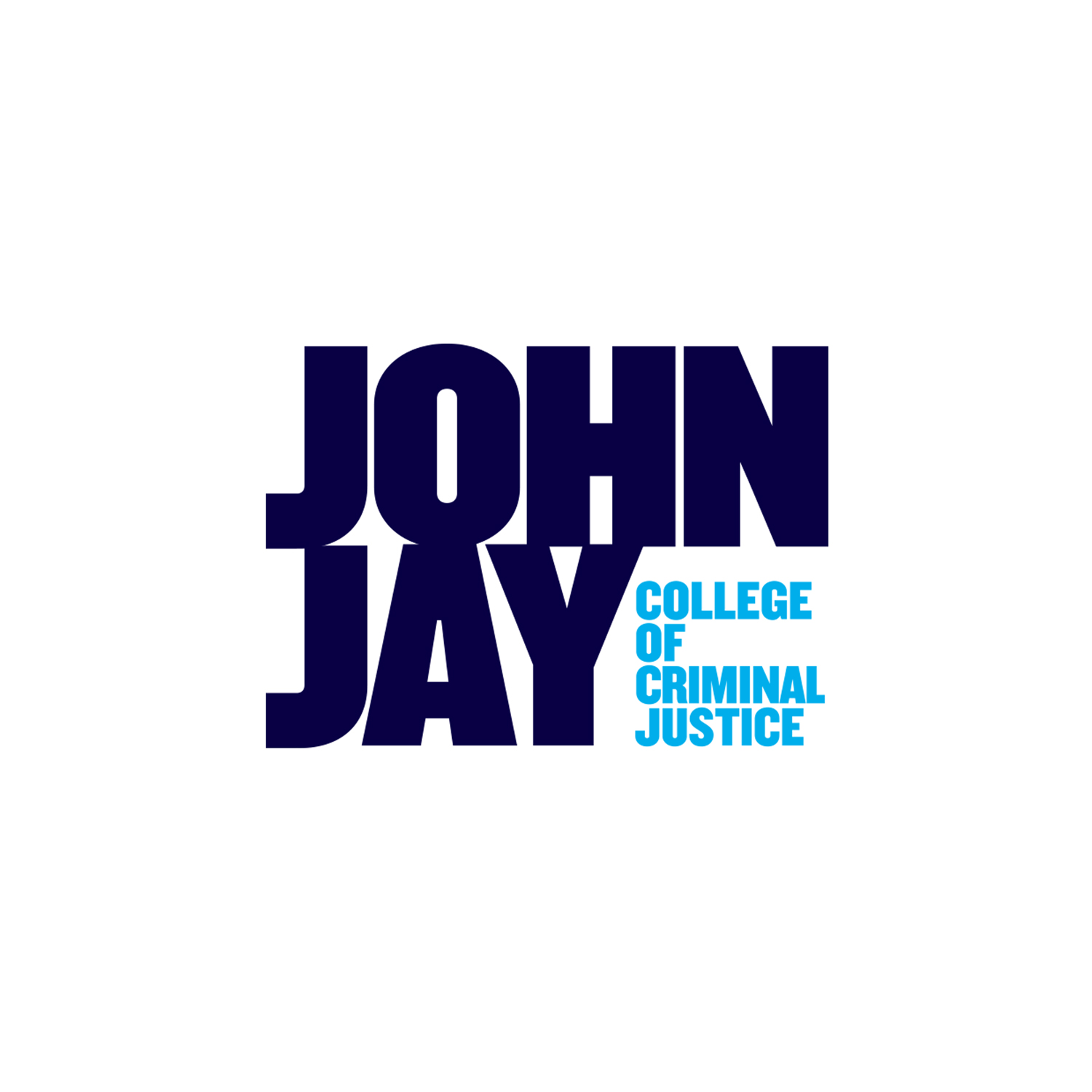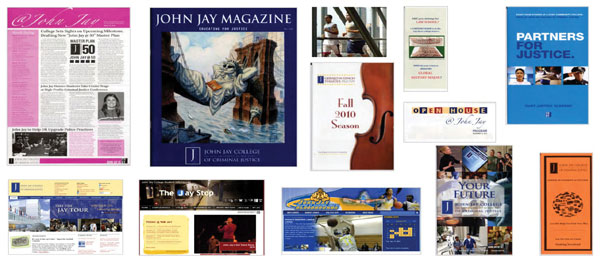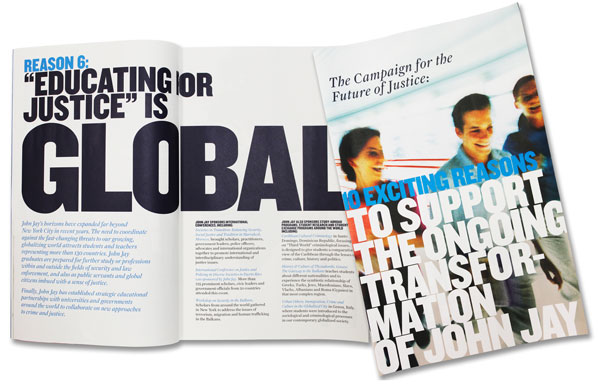Branding A “Cop College” in the Age of Social Unrest
Reflecting on various themes and insights to discuss in an article about branding, I kept coming back to the experience I had working with John Jay College of Criminal Justice and the dramatic impact this program has produced for the college. This ignited my decision to present this program as a framework for discussing all of the issues surrounding a comprehensive branding program, from its inception through its evolution and enrichment. One of the valuable by-products of discussing the John Jay brand is the role it, and its President, have played in addressing the inflammatory issues surrounding social and criminal justice these past five years.
Program Impact
The college has been around for 50 years, founded at a time not unlike the present day when there was deep concern about the role of police and urban American issues of race, conflict and violence. When a number of national commissions recommended that police officers get a college education to better prepare for their role, John Jay was formed to serve as the police academy of the New York City Police Department. It offered courses on Shakespeare, chemistry and social sciences, as well as criminal justice and law. Fast-forward to today, John Jay is now a college of 15,000 students offering a broad range of majors. Some students still go into law enforcement, but an increasing number are moving on to medical school, law school and a wide variety of professions.
As part of the City University of New York (CUNY), the largest public urban university in the world with over 500,000 students, the college provides access to students who come from immigrant and working-class backgrounds where higher education is not typically part of the family conversation. When Jeremy Travis was appointed President over a decade ago, the institution initiated a major transformation program. They became a full four-year liberal arts college,” phased out the Associate’s Degree, and accepted baccalaureate, masters and doctoral students. This put pressure on the college to raise its profile in the world of philanthropy, corporate affairs, and civic life.
Coping with this major transformation, in the words of President Travis, “brought to the surface some deep questions about our identity and our future and past and how we were going to reconcile where we wanted to be—our aspirations against our history. The notion of John Jay as a vocational school, trade school or a cop college was a drag on our identity. This limiting image got in the way of recruiting the best faculty and best students, raising money for research and new projects and positioning the college nationally and internationally.”
To lay the foundation for the brand platform, we emphasized that a brand identity is derived from a clearly defined purpose—your overriding reason for being, what problems you are trying to solve, and the driving force behind the college’s strategies, decisions and investments. In other words, Your True North. Given all the disruption and change at the college, defining a clear and upbeat purpose would provide coherence for the faculty, students, alumni, board and donors. It could be their positioning or be the force behind a distinctive, memorable positioning.
When we work on a project of this scale, we structure our research into three areas. One, the dynamics of the market they are operating in. Two, the multiplicity of audiences that we want to engage with and support the college. And, what we believe to be the most critical consideration: Engaging all the stakeholder groups on the campus to define the culture, unique strengths and passions that provide the foundation for defining the college’s purpose, positioning and voice.
In looking into the competitive educational space they were operating in we found a profusion of noise in the marketplace. We looked for opportunities to differentiate the college. Who’s in the space? How are they positioning their programs? What do they stand for? How is John Jay perceived? What are the misconceptions about John Jay? Do we see any leverage points—how can we move the needle, differentiate the college and opportunities to own a new and exciting brand identity.
We had to address a vast array of audiences who have influence in any educational institution. The Provost, Deans, and Faculty will play an active role in bringing support and credibility to any brand identity program. The students were a particularly challenging audience. The student body is incredibly diverse, politically correct, financially challenged and eager to translate their education into a job. An upbeat and informed alumni is critical to making this transformation successful. Finally, the college has an accomplished Foundation Board that plays a vital role in raising financing for special programs, research, and events.
Our process for drawing out the unique character, programs, and passions at the college was highly interactive and engaging for all stakeholder groups on the campus. We made presentations to the faculty senate. We held extensive focus group sessions with students and conducted individual interviews with all of the members of the Board. We went outside the college to talk with leaders in the educational market and media and reviewed all the literature produced by the marketing and public affairs departments. And we carefully studied every speech their exceptionally articulate president had ever given.
All this research brought to the surface deep insights about the college’s identity and how we might reconcile where the president and his leadership team wanted to be—their aspirations against their history, their future versus their past. We had to articulate any contradictions and tensions that needed to be resolved before we could move forward. The college had already completed a market research study, which provided invaluable information about where John Jay stood in the market, how they compared to competitors, and opportunities to differentiate the college from competitors. It indicated how the students felt about the college, what they were looking for in the future and what their parents were looking for. Some of the most interesting and salient insights came from in-depth interviews with guidance counselors in high schools.
All the research findings confirmed that John Jay had been transformed into the preeminent national and international leader in educating for justice—a broadly envisioned educational experience embracing social, economic, political and criminal justice. A new and exciting vision for education in justice provided its students with the skills, insights and passion to become positive agents of change.
We found that John Jay students were defined by their resilience, their passion for justice and their aspiration to public service. The college’s focus according to President Travis “… is to subject this passion to the rigors of critical thinking and analysis and to test and support their aspirations by building bridges between the world of intellect and imagination and the world of practice.”
Courage, resilience, integrity, progress and impact—the attributes of the John Jay community—was captured in an inspiring and bold PURPOSE for the college:
It is important to emphasize that this purpose statement is not an advertising slogan. It is a standard bearer of what the college stands for, a rallying cry and a lens for making strategic decisions. It dramatically sets the college apart from its competitors. This is enhanced by the fact that President Travis is an authentic and articulate spokesperson for this proactive new direction.
The purpose statement then provided the foundation for the college’s positioning statement:
AS FIERCE ADVOCATES FOR JUSTICE, WE ARE DEDICATED TO PROVIDING A NEW VISION FOR AN EDUCATION IN JUSTICE THAT IMBUES OUR GRADUATES WITH THE SKILLS, INSIGHTS AND PASSION TO BECOME POSITIVE AGENTS OF CHANGE.
We also wanted to reinforce that John Jay looked at JUSTICE through many different lenses by developing a graphic that embedded the many faces of justice—from criminal to religious to political and, for the English faculty, poetic—into their traditional EDUCATING FOR JUSTICE tag line.
Another critical element in this program is the brand voice—the way we speak to all of the constituents with a distinctive, clear and authentic voice across all platforms.
We felt the college’s communications should be BOLD, HUMAN, DYNAMIC and CLEAR. As fierce advocates for justice and leaders of change, we want to inspire people to stand up and take notice.
“It has given us a language. The multiple definitions of justice allow us to talk about expression and our value proposition in an effective way. It has helped us in talking to and recruiting new students, promoting scholarships and positioning the college for the future,” according to President Travis.
When this strategy work was presented to the president and his staff, the faculty, and the foundation board, it was approved with enthusiasm. They sensed that it captured who they were, their institutional values, educational philosophy, aspirations, and distinctiveness. Unlike experiences I have had with a few other institutions, we were able to immediately move ahead to build out the program without getting distracted by layers of approvals from various committees that would disrupt and complicate things. In the words of the dean of the advertising business, David Ogilvy:
Search the parks in all your cities
You’ll find no statues of committees.
The final element we had to consider was the visual identity system. We conducted an audit of all the college’s communications. When we showed the displays of disparate and uncoordinated materials produced across the college, President Travis said, “Oh my Lord, what have we done?”
The focal point of the new visual identity is a big, bold, powerful expression for John Jay. The design system featured upbeat photography in the print materials, elegant videos and a refreshed website. The organization’s PURPOSE was stenciled in large type on walls along with the graphic depicting the expanded definition of justice. We maintained continuity across all the publications by using JUSTICE in the names—Justice Matters is the name of the semi-annual magazine sent to all students, faculty, alumni and thought leaders in the justice field.
This was a “big, bold statement” that felt appropriate for a major New York City institution and a fierce advocate for justice.
Good Things Come in Threes
There are three programs that have been extremely effective for John Jay.
A fundraising campaign
The Justice Awards
An exciting advertising program launched earlier this year to build the college’s visibility and attract the best high school seniors in the region
Justice Should be Supported
To support its first significant fundraising campaign, the college prepared a handsome, fact-filled newsprint magazine, 10 Exciting Reasons To Support The Ongoing Transformation of John Jay. It contained a comprehensive explanation of the reimagined academic programs, the revitalized faculty—including background on Pulitzer and Presidential award winners, a presentation of the major research programs, the global reach of its programs, and a listing of John Jay graduates with leadership positions in the public and private sector. The information in this publication provided invaluable source material for proposals, presentations and other communications.
Justice Should Be Rewarded
Every two years we provide Justice Awards to three people who are fierce advocates of justice. Elie Weisel is one of the recent awardees. Last year Gloria Steinem, Bryan Stevenson, and Anthony McGill were honored for their accomplishments in the face of injustice.
“All over the world, I hear children say two things: it’s not fair, and you’re not the boss of me!” – Gloria Steinem
“Most of us think if there are places in our community where there's despair and neglect, stay as far away from those places as possible. I think justice means the opposite. I don’t think we can do justice until we get proximate to the places where injustice prevails.” – Bryan Stevenson, the Founder and Executive Director of the Equal Justice Initiative
Justice Can Be Your Vocation
Finally, the college introduced an extremely successful advertising campaign on the New York City subways. The first ad copy said, “Go To Any College To Learn To Write Code. Come Here If You Want To Learn How To Right Wrongs. There are seven ads in the campaign that were viewed by over 6 million subway riders, along with 2 million connections on a special digital version.
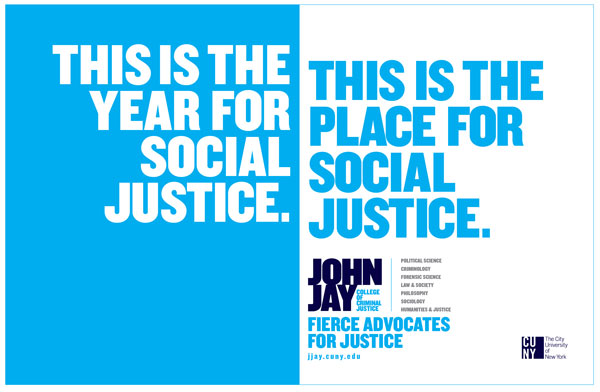
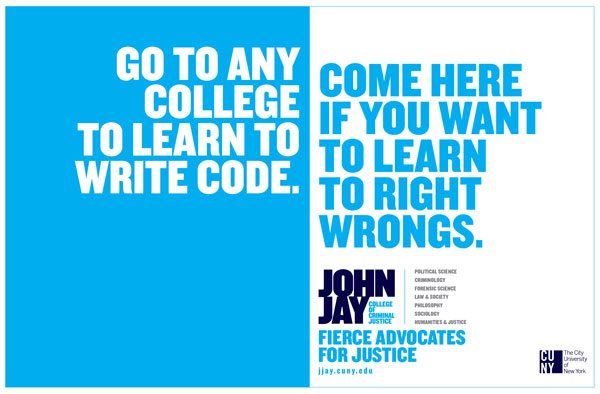
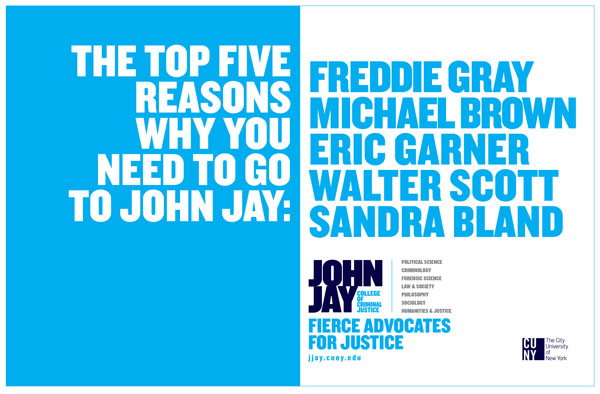
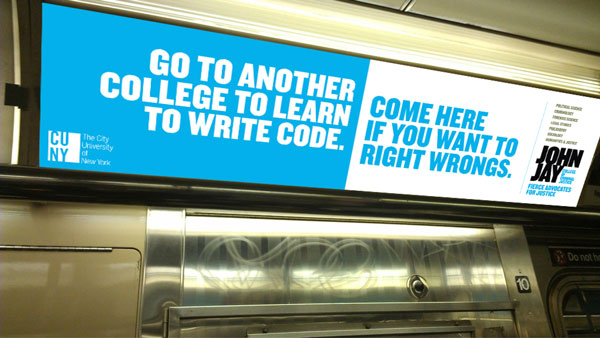
Program Impact
This program has been a major force in the success John Jay has experienced in the past 4 to 5 years. Here are just a few highlights:
Annual fundraising increased 60% when the program was first introduced and has continued to grow at similar rates since. The number of alumni donors has jumped by 35%, and alumni have contributed over 50% more in recent years.
There has been at least a 34% increase in applications since the advertising campaign was mounted.
The foundation board has successfully recruited 12 new highly motivated and accomplished members including alumni, business leaders, and not-for-profit executives.
The college ranked #3 in the Military Times “Best Programs for Vets.”
“So let me tell you how this program fits so well with this institution and to me personally,” President Travis mentioned in his annual address. “When we welcome a new class we say—‘Welcome to a community of fierce advocates for justice.’ When we first opened our new building, Secretary of State Hillary Clinton attended.
When I introduced her I said: ‘Secretary Clinton, you occupy a position once held by our founding father John Jay. Welcome to John Jay. You too are a fierce advocate for justice.”
Fierce Advocates for Justice. Those four words have given John Jay a powerful identity and a reenergized future. Our work here is done.

